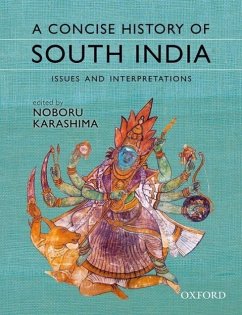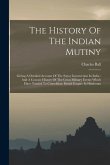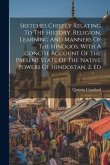- Broschiertes Buch
- Merkliste
- Auf die Merkliste
- Bewerten Bewerten
- Teilen
- Produkt teilen
- Produkterinnerung
- Produkterinnerung
This book presents the history of South India from the earliest historical periods to the present times. It takes up all the important and controversial issues in various periods of South Indian history and gives their interpretations made by recent scholars, thus affording the readers a standard and enjoyable history of South India.
Andere Kunden interessierten sich auch für
![A Catechism of Universal History [microform]: Containing a Concise Account of the Most Striking Events, From the Earliest Ages to the Present Time, Wi A Catechism of Universal History [microform]: Containing a Concise Account of the Most Striking Events, From the Earliest Ages to the Present Time, Wi]() A Catechism of Universal History [microform]: Containing a Concise Account of the Most Striking Events, From the Earliest Ages to the Present Time, Wi20,99 €
A Catechism of Universal History [microform]: Containing a Concise Account of the Most Striking Events, From the Earliest Ages to the Present Time, Wi20,99 €![A Concise History of Mexico A Concise History of Mexico]() Jan BazantA Concise History of Mexico39,99 €
Jan BazantA Concise History of Mexico39,99 €![Soldiers in King Philip's War: Being a Critical Account of That war, With a Concise History of The Soldiers in King Philip's War: Being a Critical Account of That war, With a Concise History of The]() George Madison BodgeSoldiers in King Philip's War: Being a Critical Account of That war, With a Concise History of The30,99 €
George Madison BodgeSoldiers in King Philip's War: Being a Critical Account of That war, With a Concise History of The30,99 €![The History Of The Indian Mutiny: Giving A Detailed Account Of The Sepoy Insurrection In India: And A Concise History Of The Great Military Events Whi The History Of The Indian Mutiny: Giving A Detailed Account Of The Sepoy Insurrection In India: And A Concise History Of The Great Military Events Whi]() Charles BallThe History Of The Indian Mutiny: Giving A Detailed Account Of The Sepoy Insurrection In India: And A Concise History Of The Great Military Events Whi23,99 €
Charles BallThe History Of The Indian Mutiny: Giving A Detailed Account Of The Sepoy Insurrection In India: And A Concise History Of The Great Military Events Whi23,99 €![A short history of the Saracens, being a concise account of the rise and decline of the Saracenic power and of the economic, social and intellectual development of the Arab nation from the earliest times to the destruction of Bagdad, and the expulsion of A short history of the Saracens, being a concise account of the rise and decline of the Saracenic power and of the economic, social and intellectual development of the Arab nation from the earliest times to the destruction of Bagdad, and the expulsion of]() Ameer Ali SyedA short history of the Saracens, being a concise account of the rise and decline of the Saracenic power and of the economic, social and intellectual development of the Arab nation from the earliest times to the destruction of Bagdad, and the expulsion of38,99 €
Ameer Ali SyedA short history of the Saracens, being a concise account of the rise and decline of the Saracenic power and of the economic, social and intellectual development of the Arab nation from the earliest times to the destruction of Bagdad, and the expulsion of38,99 €![A Short History of Algiers: With a Concise View of the Origin of the Rupture Between Algiers and the United States: To Which Is Added, a Copious A A Short History of Algiers: With a Concise View of the Origin of the Rupture Between Algiers and the United States: To Which Is Added, a Copious A]() Mathew CareyA Short History of Algiers: With a Concise View of the Origin of the Rupture Between Algiers and the United States: To Which Is Added, a Copious A17,99 €
Mathew CareyA Short History of Algiers: With a Concise View of the Origin of the Rupture Between Algiers and the United States: To Which Is Added, a Copious A17,99 €![Sketches Chiefly Relating To The History, Religion, Learning And Manners Of The Hindoos, With A Concise Account Of The Present State Of The Native Pow Sketches Chiefly Relating To The History, Religion, Learning And Manners Of The Hindoos, With A Concise Account Of The Present State Of The Native Pow]() Quintin CraufurdSketches Chiefly Relating To The History, Religion, Learning And Manners Of The Hindoos, With A Concise Account Of The Present State Of The Native Pow27,99 €
Quintin CraufurdSketches Chiefly Relating To The History, Religion, Learning And Manners Of The Hindoos, With A Concise Account Of The Present State Of The Native Pow27,99 €-
-
-
This book presents the history of South India from the earliest historical periods to the present times. It takes up all the important and controversial issues in various periods of South Indian history and gives their interpretations made by recent scholars, thus affording the readers a standard and enjoyable history of South India.
Hinweis: Dieser Artikel kann nur an eine deutsche Lieferadresse ausgeliefert werden.
Hinweis: Dieser Artikel kann nur an eine deutsche Lieferadresse ausgeliefert werden.
Produktdetails
- Produktdetails
- Verlag: Oxford University Press
- Seitenzahl: 418
- Erscheinungstermin: 31. Juli 2014
- Englisch
- Abmessung: 239mm x 183mm x 28mm
- Gewicht: 676g
- ISBN-13: 9780198099772
- ISBN-10: 0198099770
- Artikelnr.: 47865646
- Herstellerkennzeichnung
- Libri GmbH
- Europaallee 1
- 36244 Bad Hersfeld
- gpsr@libri.de
- Verlag: Oxford University Press
- Seitenzahl: 418
- Erscheinungstermin: 31. Juli 2014
- Englisch
- Abmessung: 239mm x 183mm x 28mm
- Gewicht: 676g
- ISBN-13: 9780198099772
- ISBN-10: 0198099770
- Artikelnr.: 47865646
- Herstellerkennzeichnung
- Libri GmbH
- Europaallee 1
- 36244 Bad Hersfeld
- gpsr@libri.de
Noboru Karashima is Professor Emeritus, University of Tokyo, Japan.
* Preface
* Prologue: Before Common Era: The Dravidian Issue by Noboru Karashima
* 1: Before Common Era (2): Beginning of South Indian history
* 1.1 Pre-historic cultures by P. Shanmugam
* 1.2 Megalithic burials and graffiti by Y. Subbarayalu
* 1.3 Beginning of South Indian history by Noboru Karashima
* 1.4 Brahmi script and South Indian languages by Y. Subbarayalu
* 2: 1st century BCE to th century: The Satavahanas, the three early
Tamil kingdoms, and their successors
* 2.1 The Satavahanas in the Deccan by Y. Subbarayalu
* 2.2 Sangam and post-Sangam literature by Y. Subbarayalu
* 2.3 Early Tamil kingdoms and political organisations by Y.
Subbarayalu
* 2.4 Post-Satavahana and post-Sangam polities by Y. Subbarayalu
* 2.5 Religions and religious monuments by Y. Subbarayalu
* 2.6 Roman trade and relation with Southeast Asia by Y. Subbarayalu
* 3: 6th century to 9th century: The new type kingdoms and bhakti
* 3.1 Conflict of the three kingdoms by Noboru Karashima
* 3.2 Kingship and the statecraft by Noboru Karashima
* 3.3 Agrarian development by Noboru Karashima
* 3.4 Capitals and temples by P. Shanmugam
* 3.5 Bhakti movement by Noboru Karashima
* 3.6 Women in South Indian traditional society by R. Mahalakshmi
* 4: 10th century to 12th century: Emergence of a centralized state
* 4.1 The balance of two empires by Noboru Karashima
* 4.2 The Chola state?centralised or segmentary? by Noboru Karashima
* 4.3 Changes in landholding system and society by Noboru Karashima
* 4.4 Maritime trade and merchant activities by Noboru Karashima
* 4.5 States in the Deccan and Kerala by Noboru Karashima
* 4.6 Religions and society by Noboru Karashima
* 4.7 Language and literature by H. Yamashita
* 4.8 Temples and sculptures by R. Mahalakshmi
* 5: 13th and 14th centuries: Period of social change and transition
* 5.1 Fall of old states by Noboru Karashima
* 5.2 Emergence of new jatis and supra-local/community organisations
by Noboru Karashima
* 5.3 Mathas, Saivasiddhantism, and Virasaivism by Noboru Karashima
* 6: 15th century to 17th century: Vijayanagar state and the outer
world
* 6.1 Vijayanagar and the Sultanates in the Deccan by Noboru Karashima
* 6.2 Vijayanagar state and nayakas by Noboru Karashima
* 6.3 Development of trade and industry by Noboru Karashima
* 6.4 'Hindu Sultan' and religions by Noboru Karashima
* 6.5 Architectures and sculptures by P. Shanmugam
* 6.6 Nayaka states and the emergence of new ethos by Noboru Karashima
* 6.7 Coming of Europeans by N. Ota
* 7: 18th and 19th centuries: The British rule and Indian society (The
long 19thcentury)
* 7.1 Regional states
* 7.1.1 Deccan sultanates and the hegemony of the Mughals by N. Ota
* 7.1.2 Successor State: Nizam by K. Yamada
* 7.1.3 Successor State: Mysore by N. Ota
* 7.1.4 Successor State: Tanjore by T. Inoue
* 7.1.5 Successor State: Travancore by T. Awaya
* 7.1.6 Economy and society by N. Ota
* 7.2 Colonisation of South India: East India Companies and the wars
* 7.2.1 Fortune of native powers and Carnatic Wars by N. Ota
* 7.2.2 The rise of Mysore kingdom and Mysore Wars by N. Ota
* 7.3 Incorporation into global economy
* 7.3.1 Development of market economy; Asian and European market
relation; Political and economic subordination by T. Mizushima
* 7.4 Colonial formation
* 7.4.1 Mirasidars and colonial land systems by T. Mizushima
* 7.4.2 Colonial administration and education policy in contention by
M. Shiga
* 7.5 Responses to colonial formation
* 7.5.1 Landholders in the nineteenth century by T. Mizushima
* 7.5.2 South Indian cotton industry by H. Yanagisawa
* 7.5.3 Changes in agrarian society by H. Yanagisawa
* 7.5.4 Social movements: Tamil Renaissance and new identity by M.
Shiga
* 7.5.5 Decline of the matrilineal system in modern Kerala by T. Awaya
* 8: 20th century: Independence and After
* 8.1 Towards Independence: Politics, society, and economy
* 8.1.1 Non-Brahmin movement by M. Shiga
* 8.1.2 Pre-Independence women's movements by Parvathi Menon
* 8.1.3 South Indian economy before the Independence by H. Yanagisawa
* 8.1.4 Devadasi issue by T. Inoue
* 8.1.5 New trends in music by T. Inoue
* 8.2 Independence and after: Politics, society, and economy
* 8.2.1 Language issue and the state by K. Yamada
* 8.2.2 State politics in Tamil Nadu by M. Shiga
* 8.2.3 State politics in Andhra Pradesh by K. Yamada
* 8.2.4 Post-Independence women's movements by Parvathi Menon
* 8.2.5 Industrial growth and agrarian change by H. Yanagisawa
* 8.2.6 Cinema and TV by T. Inoue
* Epilogue: Establishment of National Cuisine and South India by Noboru
Karashima
* About the Editor
* Index
* Prologue: Before Common Era: The Dravidian Issue by Noboru Karashima
* 1: Before Common Era (2): Beginning of South Indian history
* 1.1 Pre-historic cultures by P. Shanmugam
* 1.2 Megalithic burials and graffiti by Y. Subbarayalu
* 1.3 Beginning of South Indian history by Noboru Karashima
* 1.4 Brahmi script and South Indian languages by Y. Subbarayalu
* 2: 1st century BCE to th century: The Satavahanas, the three early
Tamil kingdoms, and their successors
* 2.1 The Satavahanas in the Deccan by Y. Subbarayalu
* 2.2 Sangam and post-Sangam literature by Y. Subbarayalu
* 2.3 Early Tamil kingdoms and political organisations by Y.
Subbarayalu
* 2.4 Post-Satavahana and post-Sangam polities by Y. Subbarayalu
* 2.5 Religions and religious monuments by Y. Subbarayalu
* 2.6 Roman trade and relation with Southeast Asia by Y. Subbarayalu
* 3: 6th century to 9th century: The new type kingdoms and bhakti
* 3.1 Conflict of the three kingdoms by Noboru Karashima
* 3.2 Kingship and the statecraft by Noboru Karashima
* 3.3 Agrarian development by Noboru Karashima
* 3.4 Capitals and temples by P. Shanmugam
* 3.5 Bhakti movement by Noboru Karashima
* 3.6 Women in South Indian traditional society by R. Mahalakshmi
* 4: 10th century to 12th century: Emergence of a centralized state
* 4.1 The balance of two empires by Noboru Karashima
* 4.2 The Chola state?centralised or segmentary? by Noboru Karashima
* 4.3 Changes in landholding system and society by Noboru Karashima
* 4.4 Maritime trade and merchant activities by Noboru Karashima
* 4.5 States in the Deccan and Kerala by Noboru Karashima
* 4.6 Religions and society by Noboru Karashima
* 4.7 Language and literature by H. Yamashita
* 4.8 Temples and sculptures by R. Mahalakshmi
* 5: 13th and 14th centuries: Period of social change and transition
* 5.1 Fall of old states by Noboru Karashima
* 5.2 Emergence of new jatis and supra-local/community organisations
by Noboru Karashima
* 5.3 Mathas, Saivasiddhantism, and Virasaivism by Noboru Karashima
* 6: 15th century to 17th century: Vijayanagar state and the outer
world
* 6.1 Vijayanagar and the Sultanates in the Deccan by Noboru Karashima
* 6.2 Vijayanagar state and nayakas by Noboru Karashima
* 6.3 Development of trade and industry by Noboru Karashima
* 6.4 'Hindu Sultan' and religions by Noboru Karashima
* 6.5 Architectures and sculptures by P. Shanmugam
* 6.6 Nayaka states and the emergence of new ethos by Noboru Karashima
* 6.7 Coming of Europeans by N. Ota
* 7: 18th and 19th centuries: The British rule and Indian society (The
long 19thcentury)
* 7.1 Regional states
* 7.1.1 Deccan sultanates and the hegemony of the Mughals by N. Ota
* 7.1.2 Successor State: Nizam by K. Yamada
* 7.1.3 Successor State: Mysore by N. Ota
* 7.1.4 Successor State: Tanjore by T. Inoue
* 7.1.5 Successor State: Travancore by T. Awaya
* 7.1.6 Economy and society by N. Ota
* 7.2 Colonisation of South India: East India Companies and the wars
* 7.2.1 Fortune of native powers and Carnatic Wars by N. Ota
* 7.2.2 The rise of Mysore kingdom and Mysore Wars by N. Ota
* 7.3 Incorporation into global economy
* 7.3.1 Development of market economy; Asian and European market
relation; Political and economic subordination by T. Mizushima
* 7.4 Colonial formation
* 7.4.1 Mirasidars and colonial land systems by T. Mizushima
* 7.4.2 Colonial administration and education policy in contention by
M. Shiga
* 7.5 Responses to colonial formation
* 7.5.1 Landholders in the nineteenth century by T. Mizushima
* 7.5.2 South Indian cotton industry by H. Yanagisawa
* 7.5.3 Changes in agrarian society by H. Yanagisawa
* 7.5.4 Social movements: Tamil Renaissance and new identity by M.
Shiga
* 7.5.5 Decline of the matrilineal system in modern Kerala by T. Awaya
* 8: 20th century: Independence and After
* 8.1 Towards Independence: Politics, society, and economy
* 8.1.1 Non-Brahmin movement by M. Shiga
* 8.1.2 Pre-Independence women's movements by Parvathi Menon
* 8.1.3 South Indian economy before the Independence by H. Yanagisawa
* 8.1.4 Devadasi issue by T. Inoue
* 8.1.5 New trends in music by T. Inoue
* 8.2 Independence and after: Politics, society, and economy
* 8.2.1 Language issue and the state by K. Yamada
* 8.2.2 State politics in Tamil Nadu by M. Shiga
* 8.2.3 State politics in Andhra Pradesh by K. Yamada
* 8.2.4 Post-Independence women's movements by Parvathi Menon
* 8.2.5 Industrial growth and agrarian change by H. Yanagisawa
* 8.2.6 Cinema and TV by T. Inoue
* Epilogue: Establishment of National Cuisine and South India by Noboru
Karashima
* About the Editor
* Index
* Preface
* Prologue: Before Common Era: The Dravidian Issue by Noboru Karashima
* 1: Before Common Era (2): Beginning of South Indian history
* 1.1 Pre-historic cultures by P. Shanmugam
* 1.2 Megalithic burials and graffiti by Y. Subbarayalu
* 1.3 Beginning of South Indian history by Noboru Karashima
* 1.4 Brahmi script and South Indian languages by Y. Subbarayalu
* 2: 1st century BCE to th century: The Satavahanas, the three early
Tamil kingdoms, and their successors
* 2.1 The Satavahanas in the Deccan by Y. Subbarayalu
* 2.2 Sangam and post-Sangam literature by Y. Subbarayalu
* 2.3 Early Tamil kingdoms and political organisations by Y.
Subbarayalu
* 2.4 Post-Satavahana and post-Sangam polities by Y. Subbarayalu
* 2.5 Religions and religious monuments by Y. Subbarayalu
* 2.6 Roman trade and relation with Southeast Asia by Y. Subbarayalu
* 3: 6th century to 9th century: The new type kingdoms and bhakti
* 3.1 Conflict of the three kingdoms by Noboru Karashima
* 3.2 Kingship and the statecraft by Noboru Karashima
* 3.3 Agrarian development by Noboru Karashima
* 3.4 Capitals and temples by P. Shanmugam
* 3.5 Bhakti movement by Noboru Karashima
* 3.6 Women in South Indian traditional society by R. Mahalakshmi
* 4: 10th century to 12th century: Emergence of a centralized state
* 4.1 The balance of two empires by Noboru Karashima
* 4.2 The Chola state?centralised or segmentary? by Noboru Karashima
* 4.3 Changes in landholding system and society by Noboru Karashima
* 4.4 Maritime trade and merchant activities by Noboru Karashima
* 4.5 States in the Deccan and Kerala by Noboru Karashima
* 4.6 Religions and society by Noboru Karashima
* 4.7 Language and literature by H. Yamashita
* 4.8 Temples and sculptures by R. Mahalakshmi
* 5: 13th and 14th centuries: Period of social change and transition
* 5.1 Fall of old states by Noboru Karashima
* 5.2 Emergence of new jatis and supra-local/community organisations
by Noboru Karashima
* 5.3 Mathas, Saivasiddhantism, and Virasaivism by Noboru Karashima
* 6: 15th century to 17th century: Vijayanagar state and the outer
world
* 6.1 Vijayanagar and the Sultanates in the Deccan by Noboru Karashima
* 6.2 Vijayanagar state and nayakas by Noboru Karashima
* 6.3 Development of trade and industry by Noboru Karashima
* 6.4 'Hindu Sultan' and religions by Noboru Karashima
* 6.5 Architectures and sculptures by P. Shanmugam
* 6.6 Nayaka states and the emergence of new ethos by Noboru Karashima
* 6.7 Coming of Europeans by N. Ota
* 7: 18th and 19th centuries: The British rule and Indian society (The
long 19thcentury)
* 7.1 Regional states
* 7.1.1 Deccan sultanates and the hegemony of the Mughals by N. Ota
* 7.1.2 Successor State: Nizam by K. Yamada
* 7.1.3 Successor State: Mysore by N. Ota
* 7.1.4 Successor State: Tanjore by T. Inoue
* 7.1.5 Successor State: Travancore by T. Awaya
* 7.1.6 Economy and society by N. Ota
* 7.2 Colonisation of South India: East India Companies and the wars
* 7.2.1 Fortune of native powers and Carnatic Wars by N. Ota
* 7.2.2 The rise of Mysore kingdom and Mysore Wars by N. Ota
* 7.3 Incorporation into global economy
* 7.3.1 Development of market economy; Asian and European market
relation; Political and economic subordination by T. Mizushima
* 7.4 Colonial formation
* 7.4.1 Mirasidars and colonial land systems by T. Mizushima
* 7.4.2 Colonial administration and education policy in contention by
M. Shiga
* 7.5 Responses to colonial formation
* 7.5.1 Landholders in the nineteenth century by T. Mizushima
* 7.5.2 South Indian cotton industry by H. Yanagisawa
* 7.5.3 Changes in agrarian society by H. Yanagisawa
* 7.5.4 Social movements: Tamil Renaissance and new identity by M.
Shiga
* 7.5.5 Decline of the matrilineal system in modern Kerala by T. Awaya
* 8: 20th century: Independence and After
* 8.1 Towards Independence: Politics, society, and economy
* 8.1.1 Non-Brahmin movement by M. Shiga
* 8.1.2 Pre-Independence women's movements by Parvathi Menon
* 8.1.3 South Indian economy before the Independence by H. Yanagisawa
* 8.1.4 Devadasi issue by T. Inoue
* 8.1.5 New trends in music by T. Inoue
* 8.2 Independence and after: Politics, society, and economy
* 8.2.1 Language issue and the state by K. Yamada
* 8.2.2 State politics in Tamil Nadu by M. Shiga
* 8.2.3 State politics in Andhra Pradesh by K. Yamada
* 8.2.4 Post-Independence women's movements by Parvathi Menon
* 8.2.5 Industrial growth and agrarian change by H. Yanagisawa
* 8.2.6 Cinema and TV by T. Inoue
* Epilogue: Establishment of National Cuisine and South India by Noboru
Karashima
* About the Editor
* Index
* Prologue: Before Common Era: The Dravidian Issue by Noboru Karashima
* 1: Before Common Era (2): Beginning of South Indian history
* 1.1 Pre-historic cultures by P. Shanmugam
* 1.2 Megalithic burials and graffiti by Y. Subbarayalu
* 1.3 Beginning of South Indian history by Noboru Karashima
* 1.4 Brahmi script and South Indian languages by Y. Subbarayalu
* 2: 1st century BCE to th century: The Satavahanas, the three early
Tamil kingdoms, and their successors
* 2.1 The Satavahanas in the Deccan by Y. Subbarayalu
* 2.2 Sangam and post-Sangam literature by Y. Subbarayalu
* 2.3 Early Tamil kingdoms and political organisations by Y.
Subbarayalu
* 2.4 Post-Satavahana and post-Sangam polities by Y. Subbarayalu
* 2.5 Religions and religious monuments by Y. Subbarayalu
* 2.6 Roman trade and relation with Southeast Asia by Y. Subbarayalu
* 3: 6th century to 9th century: The new type kingdoms and bhakti
* 3.1 Conflict of the three kingdoms by Noboru Karashima
* 3.2 Kingship and the statecraft by Noboru Karashima
* 3.3 Agrarian development by Noboru Karashima
* 3.4 Capitals and temples by P. Shanmugam
* 3.5 Bhakti movement by Noboru Karashima
* 3.6 Women in South Indian traditional society by R. Mahalakshmi
* 4: 10th century to 12th century: Emergence of a centralized state
* 4.1 The balance of two empires by Noboru Karashima
* 4.2 The Chola state?centralised or segmentary? by Noboru Karashima
* 4.3 Changes in landholding system and society by Noboru Karashima
* 4.4 Maritime trade and merchant activities by Noboru Karashima
* 4.5 States in the Deccan and Kerala by Noboru Karashima
* 4.6 Religions and society by Noboru Karashima
* 4.7 Language and literature by H. Yamashita
* 4.8 Temples and sculptures by R. Mahalakshmi
* 5: 13th and 14th centuries: Period of social change and transition
* 5.1 Fall of old states by Noboru Karashima
* 5.2 Emergence of new jatis and supra-local/community organisations
by Noboru Karashima
* 5.3 Mathas, Saivasiddhantism, and Virasaivism by Noboru Karashima
* 6: 15th century to 17th century: Vijayanagar state and the outer
world
* 6.1 Vijayanagar and the Sultanates in the Deccan by Noboru Karashima
* 6.2 Vijayanagar state and nayakas by Noboru Karashima
* 6.3 Development of trade and industry by Noboru Karashima
* 6.4 'Hindu Sultan' and religions by Noboru Karashima
* 6.5 Architectures and sculptures by P. Shanmugam
* 6.6 Nayaka states and the emergence of new ethos by Noboru Karashima
* 6.7 Coming of Europeans by N. Ota
* 7: 18th and 19th centuries: The British rule and Indian society (The
long 19thcentury)
* 7.1 Regional states
* 7.1.1 Deccan sultanates and the hegemony of the Mughals by N. Ota
* 7.1.2 Successor State: Nizam by K. Yamada
* 7.1.3 Successor State: Mysore by N. Ota
* 7.1.4 Successor State: Tanjore by T. Inoue
* 7.1.5 Successor State: Travancore by T. Awaya
* 7.1.6 Economy and society by N. Ota
* 7.2 Colonisation of South India: East India Companies and the wars
* 7.2.1 Fortune of native powers and Carnatic Wars by N. Ota
* 7.2.2 The rise of Mysore kingdom and Mysore Wars by N. Ota
* 7.3 Incorporation into global economy
* 7.3.1 Development of market economy; Asian and European market
relation; Political and economic subordination by T. Mizushima
* 7.4 Colonial formation
* 7.4.1 Mirasidars and colonial land systems by T. Mizushima
* 7.4.2 Colonial administration and education policy in contention by
M. Shiga
* 7.5 Responses to colonial formation
* 7.5.1 Landholders in the nineteenth century by T. Mizushima
* 7.5.2 South Indian cotton industry by H. Yanagisawa
* 7.5.3 Changes in agrarian society by H. Yanagisawa
* 7.5.4 Social movements: Tamil Renaissance and new identity by M.
Shiga
* 7.5.5 Decline of the matrilineal system in modern Kerala by T. Awaya
* 8: 20th century: Independence and After
* 8.1 Towards Independence: Politics, society, and economy
* 8.1.1 Non-Brahmin movement by M. Shiga
* 8.1.2 Pre-Independence women's movements by Parvathi Menon
* 8.1.3 South Indian economy before the Independence by H. Yanagisawa
* 8.1.4 Devadasi issue by T. Inoue
* 8.1.5 New trends in music by T. Inoue
* 8.2 Independence and after: Politics, society, and economy
* 8.2.1 Language issue and the state by K. Yamada
* 8.2.2 State politics in Tamil Nadu by M. Shiga
* 8.2.3 State politics in Andhra Pradesh by K. Yamada
* 8.2.4 Post-Independence women's movements by Parvathi Menon
* 8.2.5 Industrial growth and agrarian change by H. Yanagisawa
* 8.2.6 Cinema and TV by T. Inoue
* Epilogue: Establishment of National Cuisine and South India by Noboru
Karashima
* About the Editor
* Index


![A Catechism of Universal History [microform]: Containing a Concise Account of the Most Striking Events, From the Earliest Ages to the Present Time, Wi A Catechism of Universal History [microform]: Containing a Concise Account of the Most Striking Events, From the Earliest Ages to the Present Time, Wi](https://bilder.buecher.de/produkte/66/66149/66149290m.jpg)





